“It should be more like Formula One, where you have races all around the world and all the races count toward the Championship.”
Larry Ellison in 10 March 2014 San Francisco Chronicle.
Regattas all over the world, Louis Vuitton Cup then America’s Cup in Honolulu is the current Vision. AC45s followed by AC60s but no AC72s as those are overly expensive. An Atlantic Division and a Pacific Division with division championships in Port of Rome and Shanghai.
The America’s Cup is one of the oldest international-sporting trophies in history. The cup was originally known as the ‘R.Y.S. £100 Cup‘, awarded in 1851 by the British Royal Yacht Squadron for a race around the Isle of Wight in the United Kingdom. The winning yacht was a schooner called America, owned by a syndicate of members from the still not fully formed New York Yacht Club (NYYC) 2.
Since then, the America‘s Cup has been held every three to four years, with the most recent match taking place in March 20212.
f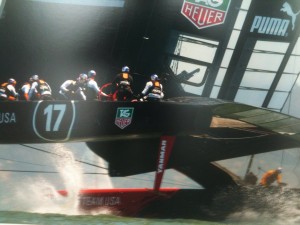
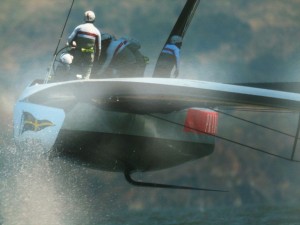
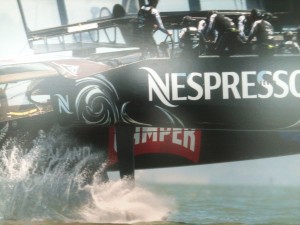
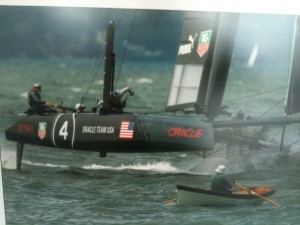
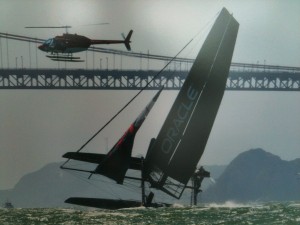
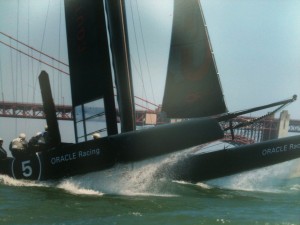
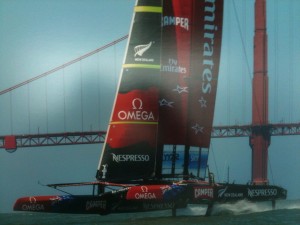
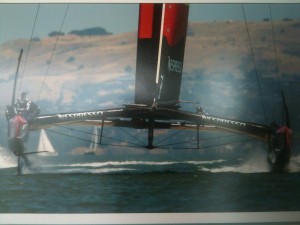
Sports that don’t make money are just hobbies for rich guys. – Larry Ellison
I understand Larry’s World view. Look at American Foot Ball and American Base Ball. These are sports that do not make money as private concerns. They exist today owing to political interests. In other words public-private partnerships. The above photos were commissioned by the US National Parks. There perhaps indicates some interest in making the America’s Cup like Foot Ball and Base Ball.
From 1851 to 1983, the USA won the America‘s Cup. After that, Australia, New Zealand, and Switzerland have been sharing the crown with the USA. The current holder of the America‘s Cup is the Royal New Zealand Yacht Squadron, which won the cup in March20212.
Foiling is the latest innovation in America’s Cup boats. It is a technology that allows the boat to lift off the water and “fly” at high speeds. The boats are equipped with hydrofoils that lift the boat off the water and reduce drag. This allows the boat to travel faster with less energy required to move it.
Foiling is a relatively new technology for America’s Cup boats and with all AC technology, recreational boaters anticipate a trickle down of this technology for their own use. In years past that had been a big part of the reason to watch the races.
But foiling on multihulled AC vessels was apparently to far removed from recreational boat design sensibilities. Interest in AC races and hence in foiling never really blossomed and while this technology has been used to great effect in the multi hulled America’s Cup boats and has made them faster than ever before, to benefit today’s recreational boater, foiling also had to be applied to monohulls. The handful of challengers in next years Barcelona AC will have foiling of interest that can be compared to long distance race boat foiling modifications (see IOMECA fleet).
Involvement of Washington State USA and the Seattle Yacht Club
The Seattle Yacht Club has competed for the America’s Cup, or in the related Challenger series held since 19701. William “Carl” Buchan, a member of the Seattle Yacht Club, was part of the crew that won the America‘s Cup in 19776. 2 decades after that an America’s Cup boat was built in Anacortes, Washington, USA. The boat, named USA-17, was a sloop-rigged racing trimaran built by the American sailing team BMW Oracle Racing to challenge for the 2010 America’s Cup6. The boat was constructed at the Core Builders facility in Anacortes2 3 4 5 . It had notable victories in the 2010 America’s Cup, with James Spithill as the skipper6
The boat had impressive performance, achieving high velocities upwind and downwind, and sailing at a significant angle off the apparent wind6. The construction of the boat in Anacortes showcased the region’s involvement in the America’s Cup and its contribution to the “Made in USA” yacht4. The boat was a sloop-rigged racing trimaran named USA-17, built by the American sailing team BMW Oracle Racing to challenge for the 2010 America’s Cup1 2 3 4 5 6
The boat was constructed at the Core Builders facility in Anacortes and had notable victories in the 2010 America’s Cup6.
James Spithill is an Australian sailor who became the youngest skipper to ever win the America’s Cup1 2. He was the helmsman and skipper for the challenging team BMW Oracle Racing 90 in the 2010 America’s Cup, and his yacht USA 17 beat the defending yacht Alinghi 5 by a considerable margin2. Spithill defended the cup twice, both times against Emirates Team New Zealand, first successfully in 2013 and then unsuccessfully in the 2017 America’s Cup held in Bermuda2. He has since skippered various boats in different races, including LDV Comanche in the Rolex Sydney Hobart Yacht Race and Luna Rossa Prada Pirelli in the 36th America’s Cup2 3
What are the airlines in the Oneworld alliance?
Here is a list of the airlines in the Oneworld Alliance, according to the search results:
- Alaska Airlines
- American Airlines
- British Airways
- Cathay Pacific
- Fiji Airways (Oneworld Connect)
- Finnair
- Iberia
- Japan Airlines
- Malaysia Airlines
- Oman Air (joining in 2024)
- Qantas
- Qatar Airways
- Royal Air Maroc
- Royal Jordanian
- SriLankan Airlines
It is worth noting that the Oneworld Alliance includes around 30 “affiliate” members, which are generally regional airlines that are owned by or have strong commercial links with Oneworld’s full members5. OneWorld Challenge represented the Seattle Yacht Club in the 2003 America’s Cup, skippered by Peter Gilmour5. OneWorld Challenge was named after the Oneworld Alliance of airlines1
What is the material of the America’s Cup Trophy base?
The trophy was originally one of three solid silver ewers made in 1848 by the Royal Jeweller in England1. The trophy was permanently donated to the New York Yacht Club in 1857 and renamed the “America’s Cup” after the first winner2 The trophy is inscribed with the names of the yachts that competed for it and has been modified twice by adding matching bases to accommodate more names2.
Which companies have sponsored the America’s Cup in the past
Here are some of the companies that have sponsored the America’s Cup in the past, according to the search results:
- Ford/Lincoln Mercury sponsored Pact 95’s boat Young America in the 1995 America’s Cup2.
- Wealthy titans have always steered the mythic, 156-year-old America’s Cup, from J. P. Morgan and Harry Vanderbilt to Ted Turner and Ernesto Bertarelli4.
- The America’s Cup has had various sponsors over the years, including Louis Vuitton, Prada, and Omega1 3 5
- the event has attracted a wide range of sponsors over the years
How much does it cost to sponsor an America’s Cup team?
The cost to sponsor an America’s Cup team can vary significantly depending on various factors such as the level of participation, team expenses, and sponsorship agreements. Here is some information
- The entry fee for the 2021 America’s Cup was $2 million per team1.
- The cost of running a team goes beyond the entry fee and can involve significant expenses for boat design, construction, maintenance, logistics, training, and personnel1.
- The infrastructure developed specifically for the America’s Cup in Auckland was reported to cost NZD$106.3 million (USD$73.4 million)2.
- The cost of hosting the America’s Cup has been reported to range from €200 million to €600 million for the next edition2.
- Luna Rossa, an Italian sailing team, announced a sponsorship deal worth NZD$109 million (US$80 million) for their 36th America’s Cup challenge3.
- Sir Ben Ainslie’s America’s Cup team secured a sponsorship deal worth $153 million5.
- The rising cost of the America’s Cup has been a topic of discussion, with some teams and events incurring significant expenses4 6.
It’s important to note that the costs associated with the America’s Cup can vary greatly depending on the specific circumstances and agreements involved.
What is the deed of gift? Has it much significance in today’s America’s Cup? Is the NYYC trying to win the cup back?
The Deed of Gift of the America’s Cup is the primary instrument that governs the rules to make a valid challenge for the America’s Cup and the rules of conduct of the races1 3
The current version of the deed of gift is the third revision of the original deed, which was written in 1852 and forwarded to the New York Yacht Club on July 8, 18571. The deed of gift describes the terms of George L. Schuyler’s presentation of the Trophy to the New York Yacht Club as a Challenge Cup and determines who may compete for the Cup2
The Cup is held in trust as a “challenge trophy” to promote friendly competition among nations1. The Deed of Gift has significant significance in today’s America’s Cup as it governs the rules for making a valid challenge for the Cup and the rules of conduct of the races1 3. The Deed of Gift has been the subject of debate and controversy in the past, with some teams and events incurring significant expenses3
However, it remains an important document that guides the America’s Cup. The New York Yacht Club has a long-standing history with the America’s Cup, having won the Cup 25 times between 1851 and 19834. The club has continued to participate in the America’s Cup, with its most recent challenge in 20214. It remains a prominent institution in the sailing community and continues to participate in the event.
What is the current status of the New York Yacht Club’s efforts to win back the America’s Cup
The current status of the New York Yacht Club’s efforts to win back the America’s Cup is as follows:
- The New York Yacht Club (NYYC) entered the 2021 America’s Cup represented by the American Magic team, led by Terry Hutchinson and Bella Mente Quantum Racing Association2 3.
- However, in October 2021, it was announced that the NYYC was pulling out of the 37th America’s Cup due to uncertainty about when and where it would be sailed1.
- In January 2022, it was reported that the NYYC would be re-partnering with their former America’s Cup team4.
The New York Yacht Club (NYYC) withdrew from the 37th America’s Cup due to two main reasons:
- COVID-19-related delays: The NYYC cited COVID-19-related delays as one of the reasons for their withdrawal from the 37th America’s Cup
- Lack of venue and timing certainty: Another reason for the NYYC’s withdrawal was the uncertainty regarding the venue and timing of the 37th America’s Cup
Overall, while the NYYC temporarily withdrew from the 37th America’s Cup, they have shown ongoing interest and involvement in the event, partnering with teams and expressing a desire to win back the Cup in the future. The NYYC’s withdrawal from the 37th America’s Cup does not indicate disinterest in the event.
The NYYC has a long-standing history with the America’s Cup and has expressed a desire to participate and win back the Cup in the future6. In February 2023, Altair and the New York Yacht Club American Magic announced a partnership for the 37th America’s Cup, expressing a determination to regain the Cup and reconnect the American sailing base with the premier event in the sport.



The sails of America’s Cup boats are designed to be as efficient as possible. They are made from lightweight materials and have carefully designed shapes that help them capture the most wind energy. This makes them faster and more efficient than traditional sails. They also are airplane wings comprised of two curtains of fabric like on biplanes. The windward facing sheet is adjusted independently from the leeward fabric to attain the best camber like on a fabric based airplane wing.
However, these sail wings are not suitable for recreational boaters. They are designed specifically for the America’s Cup and are not practical for recreational boaters. They are also expensive and require a lot of maintenance. More importantly, they can not be dropped while at sea. The adage that anyone can put up a sail but it takes a sailor to drop it really applies. The operators of the Barcelona AC boats are amazing athletes but I can’t call them sailors while they operate AC foilers. To draw the fan base, event organizers put big name sailors from other races on the AC boats but they don’t really sail. Recreational sail boating only benefits from the current AC when an uninitiated fan or athlete branches out to real sailing. However, they might also branch to airplanes.
Hydraulics
The America’s Cup boats are powered by a complex system of hydraulics. This system allows them to be steered and maneuvered with extreme precision. The hydraulics also help the boats to handle the stresses of the high speeds they are capable of achieving. Winches are eliminated
However, the complexity and cost of the system make it less for recreational boaters. The hydraulics are also very difficult to maintain and repair.
The replacement is the IC37s designed by melges for New York Yacht club
The last America’s Cup was held in 2017, and the replacement is the IC37s designed by Melges for the New York Yacht Club. The boats are a blend of modern and traditional sailing, combining elements of both for a truly unique experience. They are crewed by amateurs. The second IC37 North American Championship was held on September 23-25, 2022. The regatta included both NYYC-owend charter boats as well as privately owned boats. The Seattle Yacht Club competed.
The America’s Cup has moved away from its traditional gentlemen’s leisure sailing roots and has become an international professional sporting event that is more akin to auto or airplane races than sailing. The boats are designed to showcase robotic and airplane technology as well as to serve advertising interests.
Foiling is the latest innovation in America’s Cup boats. It is a technology that allows the boat to lift off the water and “fly” at high speeds. The boats are equipped with hydrofoils that lift the boat off the water and reduce drag. This allows the boat to travel faster with less energy required to move it.
Foiling is a relatively new technology for America’s Cup boats and with all AC technology, recreational boaters anticipate a trickle down of this technology for their own use. In years past that had been a big part of the reason to watch the races.
But foiling on multihulled AC vessels was apparently to far removed from recreational boat design sensibilities. Interest in AC races and hence in foiling never really blossomed and while this technology has been used to great effect in the multi hulled America’s Cup boats and has made them faster than ever before, to benefit today’s recreational boater, foiling also had to be applied to monohulls. The handful of challengers in next years Barcelona AC will have foiling of interest that can be compared to long distance race boat foiling modifications (see IOMECA fleet).